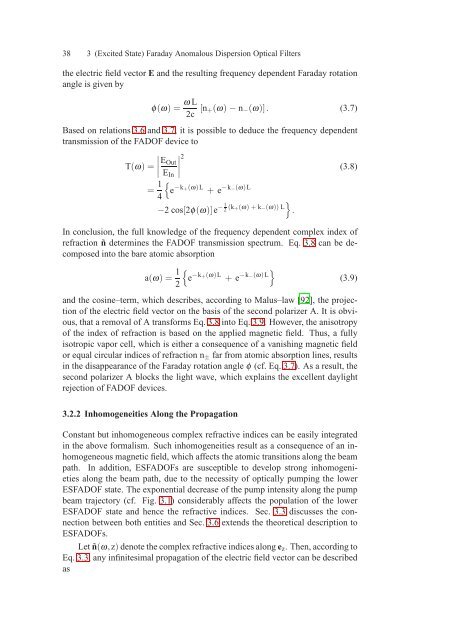Assessment of a Rubidium ESFADOF Edge-Filter as ... - tuprints
Assessment of a Rubidium ESFADOF Edge-Filter as ... - tuprints
Assessment of a Rubidium ESFADOF Edge-Filter as ... - tuprints
Create successful ePaper yourself
Turn your PDF publications into a flip-book with our unique Google optimized e-Paper software.
38 3 (Excited State) Faraday Anomalous Dispersion Optical <strong>Filter</strong>s<br />
the electric field vector E and the resulting frequency dependent Faraday rotation<br />
angle is given by<br />
φ(ω) = ω L<br />
2c [n +(ω) − n − (ω)]. (3.7)<br />
B<strong>as</strong>ed on relations 3.6 and 3.7, it is possible to deduce the frequency dependent<br />
transmission <strong>of</strong> the FADOF device to<br />
∣ T(ω) =<br />
E Out∣∣∣<br />
2<br />
∣<br />
(3.8)<br />
E In<br />
= 1 {<br />
e −k +(ω)L + e −k −(ω)L<br />
4<br />
−2 cos[2φ(ω)]e − 1 2 (k +(ω) + k − (ω)) L } .<br />
In conclusion, the full knowledge <strong>of</strong> the frequency dependent complex index <strong>of</strong><br />
refraction ñ determines the FADOF transmission spectrum. Eq. 3.8 can be decomposed<br />
into the bare atomic absorption<br />
a(ω) = 1 2<br />
{<br />
e −k +(ω)L + e −k −(ω)L } (3.9)<br />
and the cosine–term, which describes, according to Malus–law [92], the projection<br />
<strong>of</strong> the electric field vector on the b<strong>as</strong>is <strong>of</strong> the second polarizer A. It is obvious,<br />
that a removal <strong>of</strong> A transforms Eq. 3.8 into Eq. 3.9. However, the anisotropy<br />
<strong>of</strong> the index <strong>of</strong> refraction is b<strong>as</strong>ed on the applied magnetic field. Thus, a fully<br />
isotropic vapor cell, which is either a consequence <strong>of</strong> a vanishing magnetic field<br />
or equal circular indices <strong>of</strong> refraction n ± far from atomic absorption lines, results<br />
in the disappearance <strong>of</strong> the Faraday rotation angle φ (cf. Eq. 3.7). As a result, the<br />
second polarizer A blocks the light wave, which explains the excellent daylight<br />
rejection <strong>of</strong> FADOF devices.<br />
3.2.2 Inhomogeneities Along the Propagation<br />
Constant but inhomogeneous complex refractive indices can be e<strong>as</strong>ily integrated<br />
in the above formalism. Such inhomogeneities result <strong>as</strong> a consequence <strong>of</strong> an inhomogeneous<br />
magnetic field, which affects the atomic transitions along the beam<br />
path. In addition, <strong>ESFADOF</strong>s are susceptible to develop strong inhomogenieties<br />
along the beam path, due to the necessity <strong>of</strong> optically pumping the lower<br />
<strong>ESFADOF</strong> state. The exponential decre<strong>as</strong>e <strong>of</strong> the pump intensity along the pump<br />
beam trajectory (cf. Fig. 3.1) considerably affects the population <strong>of</strong> the lower<br />
<strong>ESFADOF</strong> state and hence the refractive indices. Sec. 3.3 discusses the connection<br />
between both entities and Sec. 3.6 extends the theoretical description to<br />
<strong>ESFADOF</strong>s.<br />
Let ñ(ω,z) denote the complex refractive indices along e z . Then, according to<br />
Eq. 3.3, any infinitesimal propagation <strong>of</strong> the electric field vector can be described<br />
<strong>as</strong>
















